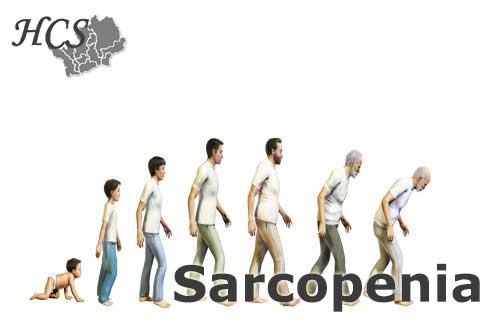Sarcopenia
As we age, we naturally lose muscle and become weaker; this can result in frailty or disability and increase our risk of falls. It may be obvious to older people themselves, but until recently the problem has received little attention from the medical profession. With your help, we have investigated ways of measuring the size and strength of muscles, and we are beginning to understand what influences them in later life.
The quickest, cheapest and easiest way to assess muscle strength is by squeezing a hand grip dynamometer. Nearly everyone who came to our clinics took this test; many also had the strength of their thighs measured by pushing against a weight whilst lying down. After this first assessment, some people returned to local clinics to have the size, rather than the strength, of their muscles measured using a DXA scanner, or travelled to Cambridge where there is a more specialised scanning machine. A small number of people were invited to our clinical research unit at Southampton General Hospital where a tiny piece of muscle was taken from their thigh under local anaesthetic and examined under a microscope.
Findings from these studies include:
Experiences in the womb and early in life affect the amount of muscle we build. For example, people who were smaller babies had lower density of muscle fibres in later life (1) and were less strong (2). Meanwhile, men who were breast-fed as babies were stronger than those who were not (3), but this was not so in women.
Experiences in adult life affect the amount of muscle we lose, for example inflammatory processes lower grip strength (4) whilst diet may help protect us – people who ate more oily fish were stronger (5).
Loss of muscle has serious consequences: people with lower grip strength in clinic had worse quality of life (assessed by questionnaire) (6) and higher levels of disability than others.
Lately, doctors have defined a cut-point in muscle, below which a condition called sarcopenia is defined (in the same way that a cut-point in the amount of haemoglobin in blood defines anaemia). Using this new cut-point, we have shown that around 5% of men and 8% of women in HCS had sarcopenia (7).
The practical outcome of this research is that the importance of muscle size and strength in later life is much more widely acknowledged – before long we expect to see grip strength measurement used routinely in geriatric clinics across the country (8), helping to identify people who might struggle to care for themselves.
Reference List
- Patel HP, Jameson KA, Syddall HE, Martin HJ, Stewart CE, Cooper C, et al. Developmental influences, muscle morphology, and sarcopenia in community-dwelling older men. JGerontolA BiolSciMedSci. 2012;67:82-7.
- Sayer AA, Syddall HE, Gilbody HJ, Dennison EM, Cooper C. Does sarcopenia originate in early life? Findings from the Hertfordshire cohort study. J GerontolA Biol Sci Med Sci. 2004;59:M930-M4.
- Robinson SM, Simmonds SJ, Jameson KA, Syddall HE, Dennison EM, Cooper C, et al. Muscle strength in older community-dwelling men is related to type of milk feeding in infancy. JGerontolA BiolSciMedSci. 2012;67:990-6.
- Baylis D, Ntani G, Edwards MH, Syddall HE, Bartlett DB, Dennison EM, et al. Inflammation, telomere length, and grip strength: a 10-year longitudinal study. Calcif Tissue Int. 2014;95(1):54-63.
- Robinson SM, Jameson KA, Batelaan SF, Martin HJ, Syddall HE, Dennison EM, et al. Diet and its relationship with grip strength in community-dwelling older men and women: the Hertfordshire cohort study. J Am GeriatrSoc. 2008;56(1):84-90.
- Sayer AA, Syddall HE, Martin HJ, Dennison EM, Roberts HC, Cooper C. Is grip strength associated with health-related quality of life? Findings from the Hertfordshire Cohort Study. Age Ageing. 2006;35:409-15.
- Patel HP, Syddall HE, Jameson K, Robinson S, Denison H, Roberts HC, et al. Prevalence of sarcopenia in community-dwelling older people in the UK using the European Working Group on Sarcopenia in Older People (EWGSOP) definition: findings from the Hertfordshire Cohort Study (HCS). Age Ageing. 2013;42:378-84.
- Ibrahim K, May C, Patel HP, Baxter M, Sayer AA, Roberts H. A feasibility study of implementing grip strength measurement into routine hospital practice (GRImP): study protocol. Pilot & Feasibility Studies. 2016;2:27.

